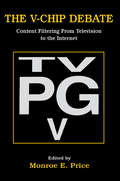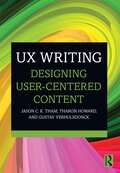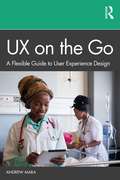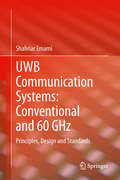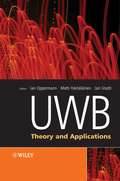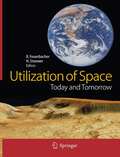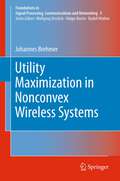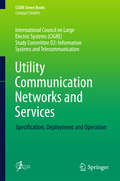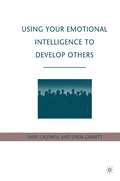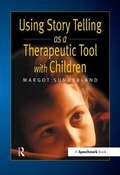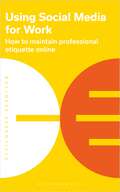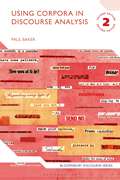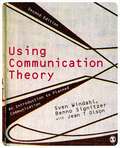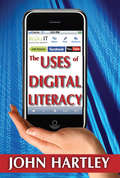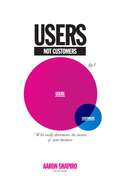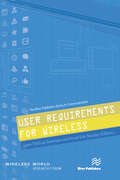- Table View
- List View
The V-chip Debate: Content Filtering From Television To the Internet (Routledge Communication Series)
by Monroe E. PriceThe V-chip is a highly significant part of the discussion about whether television (or broadcasting in general) deserves some special attention in terms of its accessibility to children, its particular power to affect conduct, and its invasiveness. But as this notion of filtering and labeling has caught the imagination of the regulator, the legislator, and all those who wish to consider new ways to alter bargaining over imagery in society, the very idea of the V-chip or its equivalent is moving across other technologies, including the Internet. The V-chip issue has also fueled the ongoing debate about violence and sexual practices in society, and how representations on television relate to those practices. Although the initial concept of the V-chip is simple, its flow into the public realm raises so many extraordinary questions that the introduction and production of the chip virtually serves as a case study in problems of law and public policy. The very conceptualization of speech in society is being affected by this issue. Accordingly, the place of the V-chip in this debate is increasingly important; indeed, it may be argued that the V-chip's contribution to legal argumentation may be greater than its ultimate contribution to the relationship between children and imagery. Among the questions the contributors address are: *What research basis is necessary to require a framework for labeling and rating? *What relationship between government and the image-producing industries can be characterized--for constitutional and other reasons--as voluntary as opposed to coercive? *Who should evaluate these images? *To what extent should the evaluation process be centralized and/or distributed? *What assessment is appropriate to evaluate whether the experiment is "successful?" In addition to the V-chip's origin's in Canada and its further evolution in the United States, this book discusses the development of the V-chip and television rating systems in Europe, Australia, and throughout the world. It also includes essays which contrast the very different approaches in Canada and the United States in terms of the role of regulatory agency, industry, and government.
UX Writing: Designing User-Centered Content
by Jason C.K. Tham Tharon Howard Gustav VerhulsdonckThis flexible textbook provides an integrated approach to user experience (UX) writing and equips students and practitioners with the essential principles and methods to succeed in writing for UX. The fundamental goal of UX writing is to produce usable and attractive content that boosts user engagement and business growth. This book teaches writers how to create content that helps users perform desired tasks while serving business needs. It is informed by user-centered design, content strategy, artificial intelligence (AI), and digital marketing communication methodologies, along with UX-related practices. By combining writing-as-design and design-as-writing, the book offers a new perspective for technical communication education where UX design and writing are merged to achieve effective and desirable outcomes. Outlining the key principles and theories for writing user-centered content design, this core textbook is fundamental reading for students and early career practitioners in UX, technical communication, digital marketing, and other areas of professional writing.
UX Writing: Designing User-Centered Content
by Jason C.K. Tham Tharon Howard Gustav VerhulsdonckThis flexible textbook provides an integrated approach to user experience (UX) writing and equips students and practitioners with the essential principles and methods to succeed in writing for UX. The fundamental goal of UX writing is to produce usable and attractive content that boosts user engagement and business growth. This book teaches writers how to create content that helps users perform desired tasks while serving business needs. It is informed by user-centered design, content strategy, artificial intelligence (AI), and digital marketing communication methodologies, along with UX-related practices. By combining writing-as-design and design-as-writing, the book offers a new perspective for technical communication education where UX design and writing are merged to achieve effective and desirable outcomes. Outlining the key principles and theories for writing user-centered content design, this core textbook is fundamental reading for students and early career practitioners in UX, technical communication, digital marketing, and other areas of professional writing.
UX on the Go: A Flexible Guide to User Experience Design
by Andrew MaraDesigned with flexibility and readers’ needs in mind, this purpose driven book offers new UX practitioners succinct and complete intructions on how to conduct user research and rapidly design interfaces and products in the classroom or the office. With 16 challenges to learn from, this comprehensive guide outlines the process of a User Experience project cycle from assembling a team to researching user needs to creating and veryifying a prototype. Practice developing a prototype in as little as a week or build your skills in two-, four-, eight-, or sixteen-week stretches. Gain insight into individual motivations, connections, and interactions; learn the three guiding principles of the design system; and discover how to shape a user’s experience to achieve goals and improve overall immediate experience, satisfaction, and well-being. Written for professionals looking to learn or expand their skills in user experience design and students studying technical communication, information technology, web and product design, business, or engingeering alike, this accessible book provides a foundational knowledge of this diverse and evolving field. A companion website will include examples of contemporary UX projects, material to illustrate key techniques, and other resources for students and instructors. Access the material at uxonthego.com.
UX on the Go: A Flexible Guide to User Experience Design
by Andrew MaraDesigned with flexibility and readers’ needs in mind, this purpose driven book offers new UX practitioners succinct and complete intructions on how to conduct user research and rapidly design interfaces and products in the classroom or the office. With 16 challenges to learn from, this comprehensive guide outlines the process of a User Experience project cycle from assembling a team to researching user needs to creating and veryifying a prototype. Practice developing a prototype in as little as a week or build your skills in two-, four-, eight-, or sixteen-week stretches. Gain insight into individual motivations, connections, and interactions; learn the three guiding principles of the design system; and discover how to shape a user’s experience to achieve goals and improve overall immediate experience, satisfaction, and well-being. Written for professionals looking to learn or expand their skills in user experience design and students studying technical communication, information technology, web and product design, business, or engingeering alike, this accessible book provides a foundational knowledge of this diverse and evolving field. A companion website will include examples of contemporary UX projects, material to illustrate key techniques, and other resources for students and instructors. Access the material at uxonthego.com.
UWB Communication Systems: Principles, Design and Standards
by Shahriar EmamiIn this book the author examines 60 GHz and conventional UWB. The book introduces the fundamentals, architectures, and applications of unified ultra wideband devices. The material includes both theory and practice and introduces ultra wideband communication systems and their applications in a systematic manner. The material is written to enable readers to design, analyze, and evaluate UWB communication systems.
UWB: Theory and Applications
by Ian Oppermann Matti Hämäläinen Jari IinattiOver the past 20 years UWB has been used for radar, sensing, military communications and niche applications. However, since the FCC ruling in 2002, which allowed the commercial operation of UWB for data communications, UWB has changed dramatically. Implementation oriented, this volume explores the fundamentals of UWB technology with particular emphasis on impulse radio (IR) techniques. It explains the key physical layer aspects of UWB technology, especially in communications and in control applications, and examines the multiple access (MAC) issues which are emerging as a hot area for practical UWB systems. Offers practical information about implementation Addresses issues of modulation possibilities, appropriate circuits for UWB, an example circuit design, MAC protocol issues and use of UWB for positioning applications Includes a literature survey examining books, articles and conference papers presenting the basic features of UWB technology and current systems Features a patent database search providing a historical perspective to the state-of-the-art technology UWB Theory and Applications will be indispensable to researchers interested in the practical issues of UWB technology and realistic assumptions of UWB, as well as engineers interested in implementing UWB devices.
Utilization of Space: Today and Tomorrow
by Berndt Feuerbacher Heinz StoewerDescribes the various fields of application of astronautics and the underlying technology. Written on a level understandable for non-specialists. Provides an outlook on the future of this fascinating field.
Utility Maximization in Nonconvex Wireless Systems (Foundations in Signal Processing, Communications and Networking #5)
by Johannes BrehmerThis monograph develops a framework for modeling and solving utility maximization problems in nonconvex wireless systems. The first part develops a model for utility optimization in wireless systems. The model is general enough to encompass a wide array of system configurations and performance objectives. Based on the general model, a set of methods for solving utility maximization problems is developed in the second part of the book. The development is based on a careful examination of the properties that are required for the application of each method. This part focuses on problems whose initial formulation does not allow for a solution by standard methods and discusses alternative approaches. The last part presents two case studies to demonstrate the application of the proposed framework. In both cases, utility maximization in multi-antenna broadcast channels is investigated.
Utility Communication Networks and Services: Specification, Deployment and Operation (CIGRE Green Books)
by Carlos SamitierThis CIGRE green book begins by addressing the specification and provision of communication services in the context of operational applications for electrical power utilities, before subsequently providing guidelines on the deployment or transformation of networks to deliver these specific communication services. Lastly, it demonstrates how these networks and their services can be monitored, operated, and maintained to ensure that the requisite high level of service quality is consistently achieved.
Using Your Emotional Intelligence to Develop Others
by S. Caldwell L. GravettA practical book detailing how to implement EI (emotional intelligence) techniques for human resource professionals and trainers developing managers and leaders.
Using Visual Evidence (UK Higher Education OUP Humanities & Social Sciences Media, Film & Cultural Studies)
by Richard Howells Robert MatsonWhat do we mean by ‘visual evidence’? How should we interpret visual texts, and what can they tell us? Why is ‘visual literacy’ so important and what benefits does it offer?Visual evidence encompasses a diverse range of media, from painting, cartoons and photography, to film, television and documentary. The central argument of this book is that visual evidence is a key to understanding both history and the present day and should not be relegated to a supporting role as merely illustrating the written word. The book shows students, scholars and researchers how to read the visual media to elicit meaning. As primary sources, visual texts can be studied not only for what is directly depicted in the painting or film but also for what it tells us about the people, cultures and societies that made them.Each chapter features fascinating case studies and examples which situate theory in real life. A major appeal of the book is the wealth of illustrations and photographs of visual texts which are included throughout. The authors make detailed reference to these examples to illustrate the theory surrounding visual evidence. An intriguing case study of an unknown girl’s photo album is just one of many examples offered, showing how we can analyze and learn from the visual text.This comprehensive and insightful edited collection brings together international media and cultural theorists, historians and art historians to demonstrate the value of visual evidence not only to media and cultural studies, but also to history, the general humanities and the social sciences.
Using Story Telling as a Therapeutic Tool with Children (Helping Children With Feelings Ser.)
by Margot SunderlandThis practical handbook begins with the philosophy and psychology underpinning the therapeutic value of story telling. It shows how to use story telling as a therapeutic tool with children and how to make an effective response when a child tells a story to you. It is an essential accompaniment to the "Helping Children with Feelings" series and covers issues such as: Why story telling is such a good way of helping children with their feelings? What resources you may need in a story-telling session? How to construct your own therapeutic story for a child? What to do when children tell stories to you? Things to do and say when working with a child's story.
Using Story Telling as a Therapeutic Tool with Children (Helping Children With Feelings Ser.)
by Margot SunderlandThis practical handbook begins with the philosophy and psychology underpinning the therapeutic value of story telling. It shows how to use story telling as a therapeutic tool with children and how to make an effective response when a child tells a story to you. It is an essential accompaniment to the "Helping Children with Feelings" series and covers issues such as: Why story telling is such a good way of helping children with their feelings? What resources you may need in a story-telling session? How to construct your own therapeutic story for a child? What to do when children tell stories to you? Things to do and say when working with a child's story.
Using Social Media for work: How to maintain professional etiquette online (Business Essentials)
by Bloomsbury PublishingEssential reading for anyone who has to work with social media in a professional capacity, from using networking sites to marketing their businesses or employers.Many people use social media every day - and it can be a vital tool in professional life. Whether you're polishing an online CV, contributing to a chat group relating to your industry sector, or using Instagram to highlight goods and services, the professional face you present needs to be strategically different to the 'social' posts that you may make outside of work. Using Social Media at Work is an easy to read, pocket-sized guide that can be dipped into for advice, tips and guidance - perfect for reading in a lunch break or on a commute. It is the ultimate etiquette guide for anyone nervous about using social media in professional settings, including: top tips, common mistakes and advice on how to avoid them, summaries of key points, and lists of the best sources of further help.
Using Social Media for work: How to maintain professional etiquette online (Business Essentials)
by Bloomsbury PublishingEssential reading for anyone who has to work with social media in a professional capacity, from using networking sites to marketing their businesses or employers.Many people use social media every day - and it can be a vital tool in professional life. Whether you're polishing an online CV, contributing to a chat group relating to your industry sector, or using Instagram to highlight goods and services, the professional face you present needs to be strategically different to the 'social' posts that you may make outside of work. Using Social Media at Work is an easy to read, pocket-sized guide that can be dipped into for advice, tips and guidance - perfect for reading in a lunch break or on a commute. It is the ultimate etiquette guide for anyone nervous about using social media in professional settings, including: top tips, common mistakes and advice on how to avoid them, summaries of key points, and lists of the best sources of further help.
Using Corpora in Discourse Analysis (Bloomsbury Discourse)
by Paul BakerHow can you carry out discourse analysis using corpus linguistics? What research questions should I ask? Which methods should you use and when? What is a collocational network or a key cluster? Introducing the major techniques, methods and tools for corpus-assisted analysis of discourse, this book answers these questions and more, showing readers how to best use corpora in their analyses of discourse. Using carefully tailored case studies, each chapter is devoted to a central technique, including frequency, concordancing and keywords, going step by step through the process of applying different analytical procedures. Introducing a wide range of different corpora, from holiday brochures to political debates, the book considers the key debates and latest advances in the field. Fully revised and updated, this new edition includes:- A new chapter on how to conduct research projects in corpus-based discourse analysis- Completely rewritten chapters on collocation and advanced techniques, using a corpus of jihadist propaganda texts and covering topics such as social media and visual analysis- Coverage of major tools, including CQPweb, AntConc, Sketch Engine and #LancsBox- Discussion of newer techniques including the derivation of lockwords and the comparison of multiple data sets for diachronic analysisWith exercises, discussion questions and suggested further readings in each chapter, this book is an excellent guide to using corpus linguistics techniques to carry out discourse analysis.
Using Corpora in Discourse Analysis (Bloomsbury Discourse)
by Paul BakerHow can you carry out discourse analysis using corpus linguistics? What research questions should I ask? Which methods should you use and when? What is a collocational network or a key cluster? Introducing the major techniques, methods and tools for corpus-assisted analysis of discourse, this book answers these questions and more, showing readers how to best use corpora in their analyses of discourse. Using carefully tailored case studies, each chapter is devoted to a central technique, including frequency, concordancing and keywords, going step by step through the process of applying different analytical procedures. Introducing a wide range of different corpora, from holiday brochures to political debates, the book considers the key debates and latest advances in the field. Fully revised and updated, this new edition includes:- A new chapter on how to conduct research projects in corpus-based discourse analysis- Completely rewritten chapters on collocation and advanced techniques, using a corpus of jihadist propaganda texts and covering topics such as social media and visual analysis- Coverage of major tools, including CQPweb, AntConc, Sketch Engine and #LancsBox- Discussion of newer techniques including the derivation of lockwords and the comparison of multiple data sets for diachronic analysisWith exercises, discussion questions and suggested further readings in each chapter, this book is an excellent guide to using corpus linguistics techniques to carry out discourse analysis.
Using Communication Theory: An Introduction to Planned Communication (PDF)
by Dr Benno Signitzer Dr Sven Windahl Jean T Olson"Using Communication Theory was a rarity in bridging the gap between ideas and practice. It was itself a model of good communication and in its second, revised edition, it is still a most reliable and accessible guide to the lessons that communication theory and research offer to practitioners, especially in planning for change. " - Denis McQuail, Professor Emeritus, University of Amsterdam "Using Communication Theory has become a classic in the education of communication. It is the comprehensive and self-evident source for theories and models, forming the base for the study of professions requiring communication planning. " - Lars#65533;ke Larsson, #65533;rebro University What does theory have to do with the practice of communication? Communication planning is used daily by thousands of people: public relations practitioners, technical writers, information campaigners, advertising professionals, organization consultants, educators, health communicators and more. Without a solid understanding of communication theory, practitioners have difficulty getting their messages heard. The second edition of this best-selling textbook has been updated with the student firmly in mind. With new learning features that directly engage with the practical side of theory, students will: Practice what they learn with activities and exercises. Apply their own experiences to theory through prompts to reflection. Consolidate their learning with highlighted definitions and lists of key terms. Take it further with boxed excerpts from classic texts. Showing how theories relate directly to the planning and experience of effective communication, Using Communication Theory - 2nd Edition provides indispensable insights into the practical nature of communication theory. In today's landscape of communication overload, this book remains an essential, authoritative guide for both students and practitioners.
Using Communication Theory: An Introduction to Planned Communication
by Dr Benno Signitzer Dr Sven Windahl Jean T Olson"Using Communication Theory was a rarity in bridging the gap between ideas and practice. It was itself a model of good communication and in its second, revised edition, it is still a most reliable and accessible guide to the lessons that communication theory and research offer to practitioners, especially in planning for change." - Denis McQuail, Professor Emeritus, University of Amsterdam "Using Communication Theory has become a classic in the education of communication. It is the comprehensive and self-evident source for theories and models, forming the base for the study of professions requiring communication planning." - Larsåke Larsson, Örebro University What does theory have to do with the practice of communication? Communication planning is used daily by thousands of people: public relations practitioners, technical writers, information campaigners, advertising professionals, organization consultants, educators, health communicators and more. Without a solid understanding of communication theory, practitioners have difficulty getting their messages heard. The second edition of this best-selling textbook has been updated with the student firmly in mind. With new learning features that directly engage with the practical side of theory, students will: Practice what they learn with activities and exercises. Apply their own experiences to theory through prompts to reflection. Consolidate their learning with highlighted definitions and lists of key terms. Take it further with boxed excerpts from classic texts. Showing how theories relate directly to the planning and experience of effective communication, Using Communication Theory - 2nd Edition provides indispensable insights into the practical nature of communication theory. In today’s landscape of communication overload, this book remains an essential, authoritative guide for both students and practitioners.
The Uses of Digital Literacy
by John HartleyAt the heart of this book lies a reappraisal of humanities research and its use in understanding the conditions of a consumer-led society. This is an open, investigative, critical, scientific task as well as an opportunity to engage with creative enterprise and culture. Now that every user is a publisher, consumption needs to be rethought as action not behavior, and media consumption as a mode of literacy.Online social networks and participatory media are often still ignored by professionals, denounced in the press and banned in schools. But the potential of digital literacy should not be underestimated. Fifty years after Richard Hoggart's pioneering The Uses of Literacy reshaped the educational response to popular culture, John Hartley extends Hoggart's argument into digital media. Media evolution has made possible the realism of the modern age journalism, the novel and science not to mention mass entertainment on a global scale.Hartley reassesses the historical and global context, commercial and cultural dynamics and the potential of popular productivity through analysis of the use of digital media in various domains, including creative industries, digital storytelling, YouTube, journalism, and mediated fashion. Encouraging mass participation in the evolutionary growth of knowledge, The Uses of Digital Literacy shows how today's teenage fad may become tomorrow's scientific method. Hartley claims the time has come for education to catch up with entertainment and for the professionals to learn from popular culture. This book will stimulate the imagination and stir further research.
The Uses of Digital Literacy (Creative Economy + Innovation Culture Ser.)
by John HartleyAt the heart of this book lies a reappraisal of humanities research and its use in understanding the conditions of a consumer-led society. This is an open, investigative, critical, scientific task as well as an opportunity to engage with creative enterprise and culture. Now that every user is a publisher, consumption needs to be rethought as action not behavior, and media consumption as a mode of literacy.Online social networks and participatory media are often still ignored by professionals, denounced in the press and banned in schools. But the potential of digital literacy should not be underestimated. Fifty years after Richard Hoggart's pioneering The Uses of Literacy reshaped the educational response to popular culture, John Hartley extends Hoggart's argument into digital media. Media evolution has made possible the realism of the modern age journalism, the novel and science not to mention mass entertainment on a global scale.Hartley reassesses the historical and global context, commercial and cultural dynamics and the potential of popular productivity through analysis of the use of digital media in various domains, including creative industries, digital storytelling, YouTube, journalism, and mediated fashion. Encouraging mass participation in the evolutionary growth of knowledge, The Uses of Digital Literacy shows how today's teenage fad may become tomorrow's scientific method. Hartley claims the time has come for education to catch up with entertainment and for the professionals to learn from popular culture. This book will stimulate the imagination and stir further research.
Users Not Customers: Who Really Determines the Success of Your Business
by Aaron ShapiroBoardroom conversations are adapting to a new and brutal reality; there is no such thing as an offline business. And if you don't embrace digital, you'll be out of business altogether.Blockbuster, AOL, Yahoo and Borders were all unstoppable, but they didn't see the new economic order coming. Google, Facebook, Groupon, and Twitter barely existed at the turn of the millennium, but are now rocketing ahead.Aaron Shapiro is CEO of HUGE, the leading digital agency which builds and operates websites that handle 150 million users a month and bring in $1.2 billion annually for their clients. That's the GDP of a small country. He thinks constantly about the most pressing issue in business today: how can businesses can use digital to thrive?Shapiro has studied what the businesses succeeding today have in common, and in Users First, Customers Second, he teaches us to recognise that it's not just customers who interact with the digital version of our organisations.The businesses who are now roaring ahead put the interests and the digital experience of all of their users - employees, business partners, media and anyone else who interacts with you through digital channels - ahead of everything else, including their paying customers.In a world were we are all users you have a choice: you can be sure that people are using your digital ecosystem, or you can be irrelevant.
User Requirements for Wireless
by Lene Sørensen Knud Erik SkoubyIn most IT system development processes, the identification or elicitation of user requirements is recognized as a key building block. In practice, the identification of user needs and wants is a challenge and inadequate or faulty identifications in this step of an IT system development can cause huge problems with the final product. The elicitation of user requirements as such changes according to age groups;, to gender,; to cultural settings,; and into time; and experience in the use of the system/software. User requirements, therefore, cannot be used between projects, IT systems, and different software. That makes the elicitation of user requirements an inherent part of any software development project and a resourceful activity as well. This book provides insights to the process of identifying user requirements and to different types by describing varying case studies in which technologies or software has been developed. A variety of user requirements are provided illustrating the effect of changing the targeted user group with respect to age,; to the context and the different technologies or software as well as to the difference in viewpoint on ways of involving users in the elicitation process. Cases and user requirement elements discussed in the book include: • User requirements elicitation processes for children, construction workers, and farmers• User requirements for personalized services of a broadcast company• Variations in user involvement• Practical elements of user involvement and requirements elicitation• Usable security requirements for design of privacy.
User Requirements for Wireless
by Lene Tolstrup Sørensen Knud Erik SkoubyIn most IT system development processes, the identification or elicitation of user requirements is recognized as a key building block. In practice, the identification of user needs and wants is a challenge and inadequate or faulty identifications in this step of an IT system development can cause huge problems with the final product. The elicitation of user requirements as such changes according to age groups;, to gender,; to cultural settings,; and into time; and experience in the use of the system/software. User requirements, therefore, cannot be used between projects, IT systems, and different software. That makes the elicitation of user requirements an inherent part of any software development project and a resourceful activity as well. This book provides insights to the process of identifying user requirements and to different types by describing varying case studies in which technologies or software has been developed. A variety of user requirements are provided illustrating the effect of changing the targeted user group with respect to age,; to the context and the different technologies or software as well as to the difference in viewpoint on ways of involving users in the elicitation process. Cases and user requirement elements discussed in the book include: • User requirements elicitation processes for children, construction workers, and farmers• User requirements for personalized services of a broadcast company• Variations in user involvement• Practical elements of user involvement and requirements elicitation• Usable security requirements for design of privacy.
